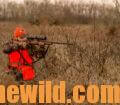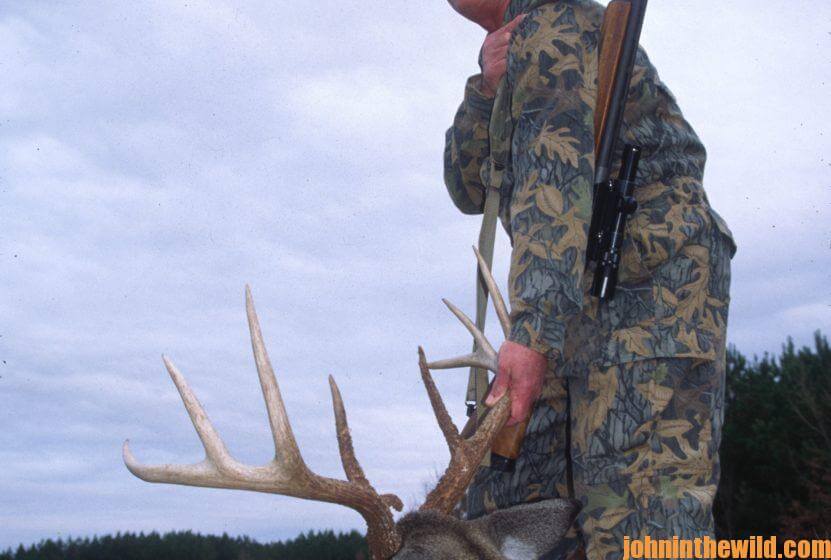Editor’s Note: One of the most-effective methods of taking game is stalking. Man was not the originator of stalking techniques, but merely the imitator. He observed cats as they stalked and killed their prey. He watched foxes move in close for their attacks. He saw other predators as they closed the distance and then came in for the kill. Because of his primitive weapons – his spear, knife and bow and arrow – early man had to learn to stalk in close if he wanted to harvest game and survive. He was a part of all that was around him. He moved with the ease of a warm summer’s breeze that never had been seen and barely felt. He was a predator who moved in for a clean kill and then left. He was a silent stalker of deer.
* Stalk Hunting Fields for Deer:
“When there’s a drizzling rain with a slight wind, hunters can stalk a green field with a bow or a gun effectively,” Avery Johnson, longtime bow hunter from Alabama, says. “If a deer is on a green field during a rain, all the woods around him are moving. By that I mean the wind is causing movement in the trees and brush, and the rain also causing movement. So, if you circle a deer by 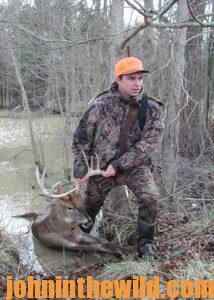 staying in the woods and downwind of him – many times you can move to within 20-30 yards of the animal that’s feeding in the field. You’ll never be able to get this close without the wind and the rain to cover your movement. But on those rainy days, you can take deer if they come on the fields.”
staying in the woods and downwind of him – many times you can move to within 20-30 yards of the animal that’s feeding in the field. You’ll never be able to get this close without the wind and the rain to cover your movement. But on those rainy days, you can take deer if they come on the fields.”
If the rain’s really pouring down, the chances are extremely good that the deer won’t be on the fields. But you still have an excellent chance of taking a deer by stalking. For one thing, the rain lets you know wind direction. You can watch the rain falling to know which way the wind’s blowing. If you hunt into the rain, then your scent won’t go into your hunting area, and the falling water will mask your footsteps. During a driving rain, deer most often will be holing up in thick cover like briarpatches of fallen down trees – anywhere they can get out of the storm.
“Realizing that’s where the deer will be and also knowing because he can’t smell or hear me that I can get extremely close before he jumps, I’ve been able to take several nice bucks while stalking,” Johnson explains. “I know that the buck will be in thick cover, and I realize that my shot will be close and quick. Hunting deer during these kinds of conditions is much like hunting quail. When the dog finds the birds and points out which cover they’re in, then all you have to do is flush them and shoot quickly to be successful. When stalking in the rain, I try to move in as quietly as possible to a thicket. Then once I’m within easy gun range of that thicket, I’ll walk straight through the middle of it, expecting a deer to break from cover at any time. I believe this is the most-effective form of stalk hunting because you eliminate so-many areas from your hunt plan. I don’t look for deer in open woods, around fields or in feeding areas. I go straight to bedding spots in thick cover. That’s where I generally will find my buck.”
* Slipping Down Roads for Deer:
One of the disadvantages I’ve found to stalk hunting bucks is that the hunter often makes too-much noise as he moves through the woods. For this reason, I prefer to stalk down logging roads, hiking trails, firebreaks or any manmade paths through the woods. Usually there will be less leaves and sticks on these paths, and a hunter can move more quietly than if he goes through the 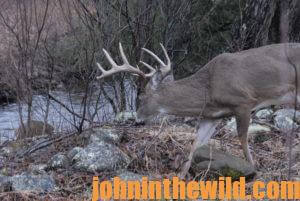 woods.
woods.
The exception to this rule is when the road or path goes through open cover where the hunter will be silhouetted against a skyline on a ridgetop, or where the road may meander through a clear-cut, and a deer can see you coming from 1/2-mile away. Most of the time a hunter who can walk slowly, extremely slowly, no more than one mile for every 2-1/2 hours spent in the woods, can see and take deer from the road. The only technique that I think is better for me than road slipping is water stalking.
* Water Stalking for Deer:
I just discovered this method of stalk hunting a few years ago when the river-bottom swamp I hunted became flooded, and the only access to some of the best hunting territory was through a thigh-high slough. However, instead of wading through the slough and coming out on the bank on the other side, I wore a pair of lightweight waders to stay in the slough and stalk.
Generally lightweight waders aren’t designed for woods hunting – and especially not wading through places that may have briars and thorns. For this reason, I’ll often put on a pair of canvas hunting britches over the waders. Then I can wade through the flooded sloughs and underwater briars and not puncture the waders and make them leak. Moving through the water gives me several advantages land hunters don’t have:
 1) The deer aren’t expecting a hunter to be in the water. Water provides a natural barrier between man and deer. Therefore when there is an expanse of water between the deer and hunting pressure, the animal feels more secure and moves more freely.
1) The deer aren’t expecting a hunter to be in the water. Water provides a natural barrier between man and deer. Therefore when there is an expanse of water between the deer and hunting pressure, the animal feels more secure and moves more freely.
2) I make very-little noise, if any, as I move through the water. I try and move slowly enough so that no waves or ringlets are noticeable on the water’s surface to spook the deer.
3) I leave no scent on the ground I travel because it’s all underwater.
4) I spook very-little game as I stalk. I’ve had beavers, muskrats and wood ducks swim within 10-15 yards of where I’m standing that aren’t spooked.
Usually my water stalking for deer is in flooded timber. So, if I see a buck off in a distance that I want to move in closer to for a shot, I almost always can keep a tree between me the buck while I’m stalking closer. And, even if the deer sees me in the water, he rarely will spook, because he’s accustomed to seeing things in the water. Nothing in the water has ever indicated danger to him. Due to the water and the standing timber, my human form is broken-up. Therefore the deer doesn’t see the outline of a man when he looks – at least not most of the time.
In a freshly-flooded woodlot, many of the acorns and other foods that deer thrive on float to the surface and ring the edge of the water – like a bathtub ring. Deer will move along the edges of the slough to feed on this food that has floated-up from the bottom. Usually I’ll see several deer in a morning of stalking in the water. Oftentimes, the deer will be out in the slough with me – feeding or swimming from one bank to the other. I’ve never spooked a swimming deer. Generally when a buck comes out of the water on the other side, he’ll usually hesitate for a minute and present a good shot, instead of running-off as soon as he exits the water.
* Knowing the Ingredients for Successfully Stalking Buck Deer: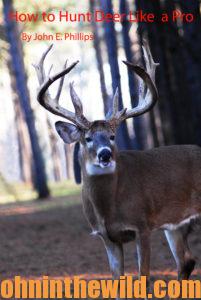
1) Patience – Usually the difference between hunters who take deer stalking and those who don’t is how much patience the hunters exhibit and how slowly they stalk.
2) Camouflage – I believe in wearing camouflage clothing and using some type of either camo paint or netting to cover your hands and face. The sun on a hunter’s hands and face will telegraph fear to a deer as quickly as a shot.
3) Warm Clothing – Without warm clothing, the hunter can’t move slowly enough and be comfortable enough to stalk effectively.
4) Reliable Gun – Have a reliable gun.
5) Small, Lightweight Binoculars – The key to being able to take a deer when stalking is to be able to see the buck before he spots you. A small, lightweight pair of binoculars will give the hunter this advantage.
To learn more about hunting deer, check out John E. Phillips’ book, “How to Hunt Deer Like a Pro,” available in Kindle, Print and Audible versions, at (http://amzn.to/YpoQHA). You may have to copy and paste this click into your browser. (When you click on this book, notice on the left where Amazon allows you to read 10% of the book for free).

